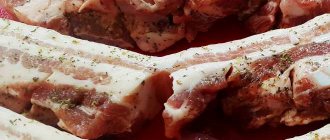It is not always possible to cook with fresh meat. At the same time, not everyone knows how and how long the product is stored in the refrigerator and freezer. Recommendations from experts will help you learn how to protect meat products for further consumption from spoilage. There are many storage methods, but to prevent the product from spoiling, you need to follow the rules and deadlines.
How to keep meat frozen
When the longest storage period is required, raw meat should be properly frozen in the freezer. First, the product must be thoroughly wiped and placed in a PE bag, from which try to release the air. It is prohibited to wash a piece of meat, otherwise the product will spoil. Large pieces are stored for a longer time, however, if you usually use small portions, then it is correct to cut the piece into the required number of pieces. This way you can defrost only the required amount of meat, and avoid repeated freezing, which will negatively affect the organoleptic properties of the product.
On a note! You can freeze the product in another way. To do this, you need to put the piece in the freezer, and when it hardens, take it out, pour cold water over it and put it in the freezer again.
This will form an ice crust, which will protect the moisture from freezing and help not to lose its juiciness. To prevent cold burn from freezing, the product must be properly prepared and packaged before storing:
- Meat and poultry can be frozen in supermarket packaging, but you must ensure that the product is tightly wrapped to prevent air from entering. Use PE bags or foil (aluminum) intended for the freezer (you need to read the label on the package) to wrap the workpieces.
- You can use a vacuum packing tool to remove the air. Vacuum tools come in different types, models and prices, and you will need special bags (purchased separately) for storing food.
- Airtight freezer containers are suitable.
- You can use thick wrappers, foil, and PE freezer bags.
- Before freezing, it is necessary to remove as many bones as possible; they only take up extra space and lead to the formation of a frost burn.
Freezer paper is placed between meat slices or cutlets to make it easier to take later for cooking. Frozen beef or other types of meat and poultry have certain shelf life.
Requirements according to GOST and SanPin
The quality of meat products in stores and enterprises is controlled by authorized bodies (Rospotrebnadzor). Periodically, they conduct inspections to determine whether meat products meet all the requirements of sanitary rules and regulations.
These requirements are prescribed by current legislative acts, which also regulate them.
A number of GOST standards have been approved for each type of meat and products made from it. Storage rules, as well as conditions for the safety of the product and its shelf life are established in accordance with GOST 28589-2014, GOST 31797-2012, GOST 31778-2012, as well as GOST 32752-2014 and others.
The safety of meat and meat products must be ensured by specialized equipment that maintains the required temperature conditions. To determine the quality of meat, two methods are used: organoleptic evaluation and testing of samples of meat and meat products directly taken from the point of sale.
Organoleptic analysis of meat is carried out before it goes on sale. Samples are examined in laboratories, after which the test is carried out by a tasting commission, which uses classification according to points prescribed in the GOST 9959-12 appendix. The test results are recorded on a tasting sheet, and a protocol is drawn up at the end of the test. Veterinary and sanitary examination is identical to organoleptic assessment, only samples are taken directly at retail outlets. They are subjected to laboratory analysis and a hygienic assessment. Based on the results of the examination, an expert opinion is drawn up.
The appearance of meat and meat products, their structure, and smell must meet the requirements for their quality.
The cut meat should not differ in color from its bulk.
The surface of the product should be free of suspicious formations, and the smell should be natural.
Quality meat must be classified according to:
- To its mass.
- The age of the animal.
- Thermal condition (chilled fresh, fresh frozen, cooked stew, boiled meat).
The quality of chilled fresh meat is characterized by a pale red, slightly dried layer on the surface of the meat, the elasticity of the fiber structure, when cut, the color of the meat should match the color characteristic of this type of meat, the juice should be transparent.
Frozen meat should be red, pinkish with a slightly gray tint at the cut site, and when re-frozen, the meat will have a dark red tint.
Stewed and boiled meat should not be tough, but have a juicy soft structure. Meat dishes should not have any foreign taste or smell.
Responsibility for a low-quality product lies with the seller and manufacturer. Products that have not passed the test and whose quality does not meet the requirements are confiscated and destroyed.
How long can meat be stored in the freezer?
It is important to know exactly how long meat can be stored in the refrigerator or freezer. You cannot keep the product in the freezer forever. Fresh meat does not last long in the refrigerator. Deadlines vary:
- raw meat (steaks or chops) can be kept in the freezer for 4-12 months.
- raw minced meat is stored only for 60-90 days.
- cooked meat dish – 60-90 days.
- sausages, ham, and frozen dinners are allowed to be kept for no more than 60 days.
- chicken (cooked or raw) – 3-12 months.
- game can be left for a year.
You need to understand at what temperature to store meat. The temperature in the freezer should not exceed -18 °C, lower is possible. You cannot defrost the equipment at this time, or you need to temporarily transfer the pieces to another chest freezer.
Proper storage of meat
It is permissible to store meat products in a cold place. And the shelf life will correspond to the specific variety and processing method.
There are several options for storing meat products, including freezing. And each of them is based on certain standards, clearly defined in the relevant GOSTs.
Taking into account the qualities and characteristics of a particular product, the storage temperature of meat is kept in the range from -30°C to +5°C.
How long can you keep in the refrigerator?
Meat is a perishable product, which is why microbacteria actively develop in it at room temperature. The fact that the meat has begun to deteriorate will be indicated by an unpleasant odor and mucus appearing on the surface. The spoiled product becomes lighter and then green. If you purchase fresh meat, for example, from a farm, then it is better not to cook it immediately after slaughtering. It should sit for 48-72 hours to become softer, juicier and easier for the body to digest. Naturally, it is better to cook meat on the day of purchase, however, usually, fresh meat is prepared for future use, which means that only a little is cooked on the same day. To store meat for a long time, it is put in the refrigerator.
On a note! Meat can be stored in the refrigerator without freezing on the bottom shelf for 48 hours if it is tenderloin from adult animals, and if from young animals, then 24 hours.
Before storing, you need to separate the pulp from the bones, this will keep it fresh longer. Do not store next to other products, this will negatively affect the shelf life. When planning to store in the refrigerator, it is wrong to place it on a wooden board, which absorbs the juice. It is good to use ceramic, glass, and plastic boards for this. Chilled meat can be stored at 0-1 °C for 72 hours.
Fresh
Raw meat is stored in the refrigerator for no more than 7 days. Vinegar essence will help. This requires 9% vinegar and a cotton cloth. The material is dipped and the piece is wrapped in it. The package is placed in a tightly closed container. There are several other ways to preserve meat without the freezer. Here are the most effective and popular:
- Nettle or bird cherry leaves. The product is covered only with collected greens and wrapped in a wet cloth. The product will remain in this form for up to 48 hours.
- A honey-milk composition will help delay spoilage for several days. You need to completely fill the product with honey or raw (not boiled) milk.
- Salt removes microbacteria perfectly. The pack is diluted in a liter or two of water (depending on the amount of fresh meat). Pieces weighing 0.2 kg wrapped in parchment paper are placed in this solution. This way the freshness is preserved for 48-72 hours.
Whichever of the proposed methods is chosen, the product must be rinsed well with clean water before using. If you have frozen meat, store it properly by slowing down the thawing process. For this, thermal bags or foil are used. Then wrap the piece of meat in a large number of towels. This will create a thermos effect.
After defrosting
Frozen meat cannot be defrosted using a microwave or hot water. So the product will become unpalatable and hard. It is correct to defrost at room temperature. This will take more time, but the prepared dish will be juicy and tasty. Therefore, if you want to cook meat in the morning, you need to defrost it at night. And if you plan to cook for dinner, you need to take a piece out of the freezer in the morning.
On a note! If you need to defrost some meat, but the house is too hot and a person is afraid to leave it on the table, then it is correct to put it from the freezer into the refrigerator, where it will thaw.
Defrosting takes 12-16 hours and must be done right before the start of cooking. It is better not to store it in the refrigerator after defrosting.
Store salted and dried fish in the refrigerator
Dried fish:
* Dried fish can be stored for quite a long time, since the salt used in its preparation plays the role of a preservative.
*Use thick wrapping paper to wrap the dried fish, then place the fish in a dry, cool place out of direct sunlight.
*If you don't have wrapping paper, you can use a tin or glass jar, which must be covered with a lid.
* In hot weather, it is better to keep fish in the freezer so that it lasts longer.
If you properly dry the fish and then store it according to the above rules, then it will be able to retain its taste for a whole year.
Helpful advice:
Do not wrap fish in newspaper as the printing ink used to print words and images contains lead.
Salty fish:
You can salt the fish at home or buy already salted fish. Moreover, in the store you can find different varieties of such fish.
If you want to keep salted fish longer, store it in brine. The shelf life depends on the amount of salt you use during preparation.
Storage in salt
When something more radical is needed, experts offer several processing methods that allow you to preserve the product for six months or longer. The method of storing in salt has been known for a long time. Fresh meat was salted using the dry method or filled with strong brine. The result could be corned beef. Traditionally, salt is used for this, but you can diversify the taste with seasonings. Usually you take the following to prepare brine:
- 30 g salt;
- liter of water.
The water must be boiled. Salted in large pieces. The salting process takes approximately 21 days. Cooked corned beef should be stored in the dark and cool. This way, salt will help preserve the freshness of the meat, and the product can be prepared for future use.
Types of meat based on heat treatment
According to the type of heat treatment, meat can be:
- Fresh meat is present for 1.5 hours after the slaughter of the animal, the temperature inside the muscles of pork of such meat is within +35 - +36 degrees, and for beef +36 - +38 degrees. It is not recommended to eat fresh meat right away; for better digestion, it needs to sit for a couple of days.
- Chilled meat, which, after cutting using refrigeration units, becomes inside the muscles from 0 to +4 degrees, while the muscle tissue is elastic and there is a dried crust.
- Frozen, when the carcass is not completely frozen, but only the layer on top, no more than 25% of the entire carcass.
- Frozen. The thickness of the muscles has a temperature of no more than -8 degrees. Proper freezing prevents spoilage of meat.
The most reliable and common methods of storing fresh meat are refrigeration and freezing. However, these processes have certain features, such as temperature and shelf life, without which the meat will deteriorate and lose its nutritional qualities.
Dry storage
Distant ancestors dried food. To do this, the meat cut into small slices was sent to the sun. This is far from hygienic, which is why today powerful dryers are used for drying; they can be bought in household appliance stores. Before placing the workpieces in the dryer, the product must be prepared:
- Cut off all the fat from the piece (if it remains, it will taste bitter).
- Cut into thin slices.
Send everything to the dryer and set the temperature to at least 75 oC. Cooking takes approximately 17–20 hours. The slices must dry completely. They can be stored in a tightly closed container without refrigeration for up to 60 days. A vacuum will help increase this period.
What does quality meat look like?
A high-quality fresh product can be recognized by the condition of its cut. In this case, consistency, color and aroma are important. The meat must have a uniform color: without fragments of other shades or spots, and the color must correspond to the species:
- lamb has a natural color - dark red;
- beef is red, and calf is pink;
- the pork should be pink;
- poultry – light meat with a pink tint.
The composition may contain streaks and small areas of fat.
A quality product can be recognized by its fresh, pleasant, barely noticeable aroma. A sour, pungent odor indicates that the product is stale.
Inclusions of white fatty layers, which have a marble-like pattern at the cut site, indicate high quality and freshness. The exception here is lamb fat: it can be creamy in color.
The consistency of good quality meat should be dense and elastic. When pressed, it should immediately return to its original position (spring). The indentations at the place of pressure should not remain.
There cannot be any mucus (not to mention mold) on the surface of a quality product.
When choosing in a store, you need to make sure that there are no smudges at the bottom of the package. This is an indicator of a low-quality product: defrosted several times or simply stale.
Small pink ice crystals located around a piece of frozen meat also indicate temperature violations during storage.
Raw meat that has a grayish tint definitely should not be purchased. Even if its packaging has a fresh release date. This product should also not be eaten. This may cause serious poisoning.
Trade workers have many ways to make expired goods look beautiful. For example, areas of pink fat indicate soaking in potassium permanganate.
In stores, as well as in markets, the degree of product quality is determined using pressure. Repeatedly thawed meat will remain dented. In this case, the cavity will immediately fill with liquid. And fresh food will immediately restore its original shape.











